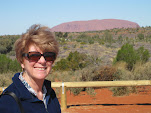We had seen most of the major tourist sites on the island, so today was a brush up on details. Hugo, also a Rapa Nui native, was full of details.
The platforms that had fallen Moai still contained the bones of the people that the Moai represented. The people in the north, near the quarry, were the builders of the Moai. The people of the south paid in various goods to have the Moai built. After a time, when it became apparent that the northerners were becoming Moai building slaves, they quit building them.
In the distance is a platform with a few topknots scattered about. All the Moai were broken, weathered, and buried.
It was cool and misty here today. Fallen Moai and a rainbow set the scene.
The statue above is supposed to be a Moai of a young boy. He was supposed to be able to heal people. People would come and he could help heal them. We're not sure how he achieved this.
Most of the platforms had crematorium next to them. The style of the platforms and the crematorium were different from tribe to tribe. Charlie and I originally thought there were only a few tribes. We were incorrect. There were apparently as many at 54 of them. Each group must have been very small. Each with their own platforms, Moai, and all. When the war broke out amongst the tribes, neighbor was literally fighting with neighbor.
The house in the photo above is in the style of the canoe house that the native Rapa Nui people constructed from stone and palm fronds.
The photo above is the local (near our hotel) boat dock. There is no wharf in town, and there isn't a port. Somehow ten or more cruise ships show up in the summer with more than 2000 people on each of them. People are let off the boats in groups of 400-500, they see very little, and are brought back to the boat. It takes two days to get everyone on board to see what little they can. Oil is brought to the island by a ship that has to be more-or-less dry docked to keep it from swinging around to much in the tide. Then divers attach pipes from under the water to a container on shore. It takes four days to empty the oil ship.
We went to a museum, but my camera ran out of battery power at the time, so no photos. It was interesting, though.
The photo above is another astronomical Moai. He is supposed to have been a great island astronomer. Hugo explained that on June 21st the sun is over his head for 10 minutes. I'm not entirely sure what he meant - the mysticism began.
The northern shore of Rapa Nui.
I'm standing next to a topknot. The curved surface was the portion that was stuck on top of the Moai's head, and balanced there.
Hugo's most interesting stories were about himself. He came from one of the northern tribes and was raised by his great-grandma. She build a stone house with a tar roof by herself (good grief). She made an attempt to sell it when she left, but it's been left standing. It is in a fishing area, and the local dock is seen in the photo above.
We've been seeing lots of petroglyphs but the octopus above is my favorite, and the easiest photo to see.
At the end of the day we went back to the 15 Moai that have been reconstructed. Horses were grazing all over the area. Since bones, belongings, and many other things are buried in the platforms, the horses hoofs tend to smash the stones, so Hugo chased them away.
To the right of the fallen Moai is the road that he was dragged on to get to a platform that was no more than 80 m from where we were standing. Hugo's guess is that once he toppled over, he was shoved to the side of the road. Months of work down the drain, and so close to the end of the road. Hugo told us how the scientists think the Moai were moved. The legend of the natives is that they "thought" them into place. hmmmmm - or better - sang them into place - I guess I'm just not mystical.
Tomorrow we begin our three flights home. We leave here around 1 PM Friday and get home 4:30 or so on Saturday.
















No comments:
Post a Comment